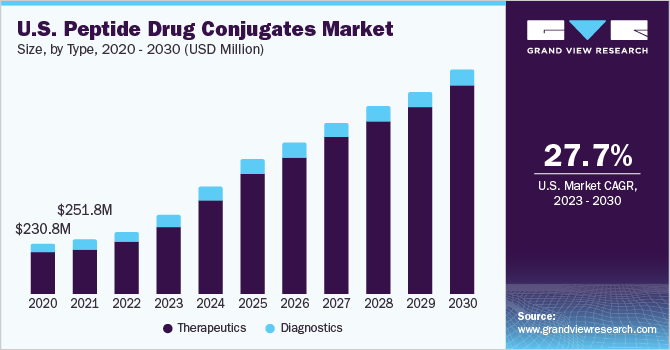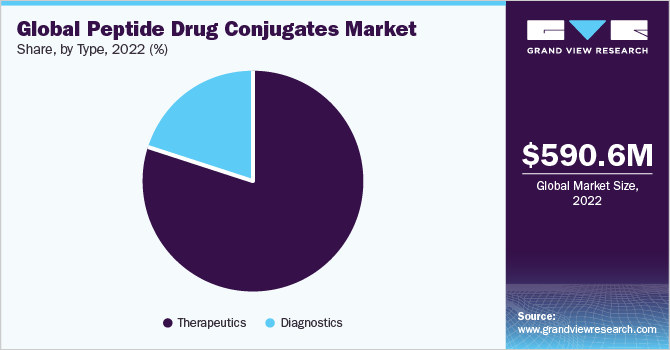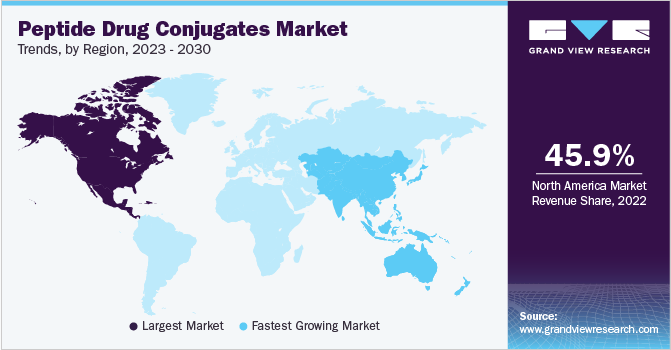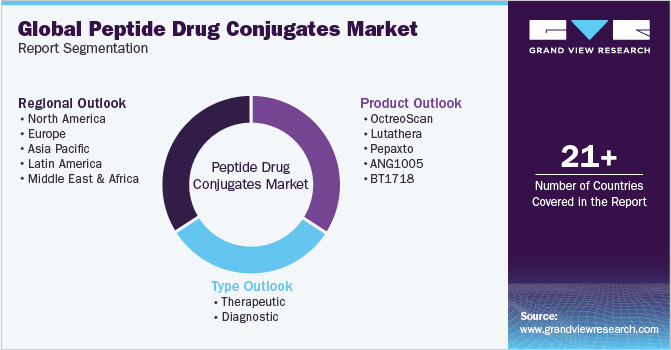- Home
- »
- Pharmaceuticals
- »
-
Peptide Drug Conjugates Market Size & Share Report, 2030GVR Report cover
![Peptide Drug Conjugates Market Size, Share & Trends Report]()
Peptide Drug Conjugates Market Size, Share & Trends Analysis Report By Product (Lutetium, Melflufen, ANG1005, BT1718, CBX-12, Other Pipeline), By type (Diagnostic, Therapeutic), By Region, And Segment Forecasts, 2023 - 2030
- Report ID: GVR-4-68040-001-8
- Number of Report Pages: 80
- Format: PDF, Horizon Databook
- Historical Range: 2018 - 2021
- Forecast Period: 2023 - 2030
- Industry: Healthcare
Report Overview
The global peptide drug conjugates market size was valued at USD 590.56 million in 2022 and is expected to grow at a compound annual growth rate (CAGR) of 28.58% from 2023 to 2030. The robust clinical trial pipeline with peptide drug conjugates (PDCs) coupled with increase in R&D investments for developing PDCs and rising disease burden across the globe and is expected to contribute to the market growth. For instance, in July 2021, Takeda Pharmaceutical Company Limited in collaboration with PeptideDream, announced to invest USD 3.5 billion to develop peptide drugs for neuromuscular disease.

Pharmaceutical companies are developing PDCs as targeted therapeutic drugs for metabolic diseases, Covid-19 viral diseases, and cancer among others. Currently, the market has presence of two FDA approved drugsPepaxto (Melflufen) and Lutathera (Lu 177 dotatate) for cancer treatment. Therefore, rising prevalence of such diseases is driving the peptide drug conjugates market. According to National Cancer Institute, in 2020, more than 1.8 million new cancer cases and more than 600,000 deaths occurred in the U.S. due to cancer.
The strong product pipeline and increasing financial investments in research and development is offering lucrative opportunity forpeptide drug conjugates market growth. For instance, AngioChem, Inc.’s product candidate- ANG1005indicated for brain tumor is undergoing phase 3 clinical study, Bicycle Therapeutics pipeline products- BT5528 & BT1718 indicated for non-small cell carcinoma, are under phase 2 clinical trials. Hence, the expected new PDC approval for treatment of multiple types of cancer will boost the market growth in coming future.
According to the national cancer institute, there are more than 250 FDA approved chemotherapeutic drugs used in treatment of malignant tumors. However, the major drawback associated with such small molecules is uncontrolled toxicity resulting into severe side effects. Moreover, increasing drug resistance of tumor cells to such agents has led to demand for better treatment approach like targeted PDCs and thereby, driving the peptide drug conjugates space.
However, low bioactivity, poor stability, long research and development time, and slow clinical development process as therapeutic agents of PDC is expected to restrain the segment, leading to increase in overall time and cost incurred for development.
Product Insights
The Lutathera product segment dominated the peptide drug conjugates market with a revenue share of 79.75% in 2022. The first FDA approved PDC is Novartis’s Lutathera(lutetium Lu 177), a radiolabeled somatostatin analog which is an advanced accelerator injection. The expected patent expiry date is 25th July 2038. It is indicated for the treatment of somatostatin receptor-positive gastroenteropancreatic neuroendocrine tumors including foregut, midgut, and hindgut neuroendocrine tumors in adults. Lutathera consist of an amide linkage between homing peptide somatostatin and cytotoxic radiotherapeutic agent 177Lu.
Oncopeptides AB received FDA approval for its first-in-class peptide-conjugated alkylator, Pepaxto (melflufen), in February 2021.The combination of Pepaxto (Melphalan flufenamide) with dexamethasone is indicated for multiple myeloma in adult patients. The drug has demonstrated anti-myeloma activity in myeloma tumor cells resistant to bortezomib and the alkylator melphalan. Melflufen patents cover major markets in the US, Japan, Canada, and Europe. However, the drug has been withdrawn from the U.S. market in October 2021, based on overall survival data from its phase 3 study.
Type Insights
Therapeutic segment dominated the peptide drug conjugates market with the revenue share of 79.89% in 2022 and is anticipated to witness the fastest growth. The factors attributing to dominance is presence of both approved PDCs, Lutathera and Pepaxto as therapeutic agents targeting tumor cells. Moreover, the presence of targeting therapeutic drugs such as ANG1005,

BT5528 and BT1718 under clinical trials is expected to boost the market over the forecast period. Along with cancer, pharmaceutical companies are developing targeting therapeutic PDCs for metabolic diseases and coronavirus diseases due to significant benefits of PDCs in therapeutic segment.
PDCs coupled with radionucleotides, can also act as diagnostic agents. For example,Mallinckrodt Pharmaceuticals’ In-DTPA-octreotide (octreoscan) which contains radioactive nucleotide, primarily used in localization of neuroendocrine tumors. Furthermore, development and applications of PDCs in diagnosis is anticipated to offer remunerative opportunity for segment growth.
Regional Insights
North America dominated the overall peptide drug conjugates (PDCs) market in terms of revenue share of 45.91% in 2022, owing to the launch of Melflufen and rapid uptake of PDC drugs in cancer therapy. Increasing awareness about current treatment options, favorable reimbursement policies, and improved patient affordability are expected to drive market growth. Furthermore, rising cases of cancer and related mortality is fueling the market growth in the region. For instance, NCI reported approximately 1,806,590 new cancer cases and 606,520 disease related deaths in 2020.

Asia Pacific is expected to witness a growth rate of 27.4% over the forecast period. The growth of the region is attributed to the upsurge in number of cancer cases and strategic initiatives undertaken by market players for regional expansion in such regions. Furthermore, rising research and development and increasing investments to develop and commercialize such novel delivery systems is anticipated to boost the market growth in the region.
Key Companies & Market Share Insights
Strategic collaborations and product launches are some of the key initiatives undertaken by companies to gain market share. For instance, in January 2023, Oncopeptides AB announced the launch of a global prelicense sales program in collaboration with Tanner Pharma Group for providing melphalan flufenamide (melflufen) in countries where the product is not commercially available.In November 2022, Cybrexa Therapeutics and Exelixis, Inc. announced the collaboration agreement providing Exelixis the right to acquire, first-in-class peptide-drug conjugate (PDC), CBX-12. This initiative is expected to expand its clinical pipeline for targeted drug therapy.
Additionally, in June 2019, Novartis AG and PeptiDream Inc. collaborated to develop PDC, macrocyclic peptide for diagnostic and therapeutic applications. Such strategic initiatives by key players are driving the market growth. Some of the key players in the peptide drug conjugates market include:
-
Novartis AG
-
Oncopeptides AB
-
Bicycle Therapeutics
-
AstraZeneca
-
Cybrexa Therapeutics
-
Angiochem Inc.
-
Innovasium Soricimed Biopharma
-
Theratechnologies
Peptide Drug Conjugates Market Report Scope
Report Attribute
Details
Market size value in 2022
USD 724.31 million
Revenue forecast in 2030
USD 4.21 billion
Growth Rate
CAGR of 28.58% from 2023 to 2030
Base year for estimation
2022
Historical data
2018 - 2021
Forecast period
2023 - 2030
Quantitative units
Revenue in USD billion/million and CAGR from 2023 to 2030
Report coverage
Revenue forecast, company ranking, competitive landscape, growth factors, and trends
Segments covered
Product, type, region
Regional scope
North America; Europe; Asia Pacific; Latin America; Middle East & Africa
Country scope
U.S.; Canada; U.K.; Germany; France; Spain; Italy; Denmark, Sweden, Norway, Japan; China; India; Australia; South Korea; Thailand, Brazil; Mexico; Argentina; South Africa; Saudi Arabia; UAE, Kuwait
Key companies profiled
Novartis AG, Bicycle Therapeutics, AstraZeneca, Cybrexa Therapeutics, Oncopeptides AB, Angiochem Inc., Innovasium Soricimed Biopharma, and Theratechnologies
Customization scope
Free report customization (equivalent up to 8 analysts working days) with purchase. Addition or alteration to country, regional & segment scope.
Pricing and purchase options
Avail customized purchase options to meet your exact research needs. Explore purchase options
Global Peptide Drug Conjugates Market Report Segmentation
This report forecasts revenue growth at the global, regional, and country levels and provides an analysis of the latest industry trends in each of the sub-segments from 2018 to 2030. For the purpose of this study, Grand View Research has segmented the global peptide drug conjugatesmarket report on the basis of product, type, and region:

-
Product Outlook (Revenue, USD Million, 2018 - 2030)
-
OctreoScan
-
Lutathera
-
Pepaxto
-
ANG1005
-
BT1718
-
-
Type Outlook (Revenue, USD Million, 2018 - 2030)
-
Therapeutic
-
Diagnostic
-
-
Regional Outlook (Revenue, USD Million; 2018 - 2030)
-
North America
-
U.S.
-
Canada
-
-
Europe
-
Germany
-
U.K.
-
France
-
Italy
-
Spain
-
Denmark
-
Sweden
-
Norway
-
-
Asia Pacific
-
China
-
India
-
Japan
-
Australia
-
South Korea
-
Thailand
-
-
Latin America
-
Brazil
-
Mexico
-
Argentina
-
-
Middle East & Africa
-
South Africa
-
Saudi Arabia
-
UAE
-
Kuwait
-
-
Frequently Asked Questions About This Report
b. The global peptide drug conjugates market is expected to witness a compound annual growth rate of 28.58% from 2023 to 2030 to reach USD 4.21 billion by 2030.
b. Based on product, Lutathera segment accounted for a share of 79.75% in 2022 as it is the first approved PDC and solves an unmet need in neuroendocrine tumors.
b. Some of the key players in the peptide drug conjugates market are Novartis AG, Bicycle Therapeutics, AstraZeneca, Cybrexa Therapeutics, Oncopeptides AB, Angiochem Inc., Innovasium Soricimed Biopharma, and Theratechnologies.
b. The major factors driving the market growth are the global upsurge in cancer cases and related mortality, robust clinical pipeline of PDCs, and uncontrolled toxicity associated with available small molecule chemotherapeutic agents.
b. The global peptide drug conjugates market size was valued at USD 590.56 million in 2022 and is anticipated to reach USD 724.31 million in 2023.
Share this report with your colleague or friend.
![gvr icn]()
NEED A CUSTOM REPORT?
We can customize every report - free of charge - including purchasing stand-alone sections or country-level reports, as well as offer affordable discounts for start-ups & universities. Contact us now
![Certified Icon]()
We are GDPR and CCPA compliant! Your transaction & personal information is safe and secure. For more details, please read our privacy policy.
We are committed towards customer satisfaction, and quality service.
"The quality of research they have done for us has been excellent."





